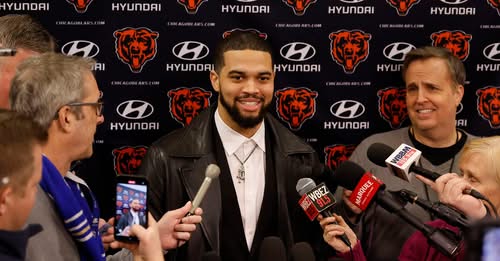Caleb Williams, the 2022 Heisman Trophy winner and former USC star, entered the 2024 NFL Draft as the consensus No. 1 overall pick, widely considered a generational quarterback talent with dazzling arm strength, pocket poise, and improvisational flair reminiscent of Patrick Mahomes. But as his name shot up draft boards and mock drafts almost unanimously linked him to the Chicago Bears, a storm was quietly brewing behind the scenes—one that has only recently come to light in a forthcoming book that details Williams’ and his father’s uneasiness with the idea of the quarterback heading to Chicago.
According to an upcoming biography authored by a prominent NFL journalist, Williams and his father, Carl Williams, had serious reservations about the Bears’ franchise from the outset. Their concerns were rooted in decades of instability at the quarterback position, a revolving door of offensive coordinators, and a losing culture that had sunk some of the league’s most promising prospects before. The book reveals that the Williams camp took proactive measures to steer Caleb away from Chicago—some subtle, others more drastic. It paints a picture of a quarterback who loved the game, believed in himself, but was wary of being another casualty in a franchise long known for mismanaging elite talent at the position.
Carl Williams, a former athlete himself who has played an integral role in Caleb’s development and career trajectory, reportedly explored several strategies to avoid the Bears. He looked into legal avenues, researched loopholes within the NFL’s collective bargaining agreement, and even entertained the possibility of having Caleb play a year in an alternative league—such as the now-revived United Football League (UFL)—to delay his NFL debut. While some may view that as extreme, others might see it as a calculated move by a father determined to protect his son’s future from a historically troubled organization.
At the heart of their concern was Chicago’s track record. Since the 1950s, the Bears have struggled to develop a true franchise quarterback. Jay Cutler may have had moments, Mitch Trubisky showed flashes, and Justin Fields inspired some hope, but none truly broke through. And for every short-lived success story, there were multiple tales of failure, scapegoating, and regime changes that stifled player growth. The Williams family worried that the infrastructure in Chicago—both on the field and in the front office—would not support Caleb in the way an elite young quarterback needs.
Yet despite all the planning and misgivings, the Williamses were facing a harsh truth about the NFL Draft: once a team owns the top pick, it essentially owns the future of any player it chooses to draft. The Bears, by virtue of a blockbuster trade with the Carolina Panthers, secured the No. 1 overall selection in 2024 and made no secret of their interest in Williams. Despite whatever signals Caleb’s camp may have sent, Chicago General Manager Ryan Poles and the organization remained steadfast in their belief that Williams was their guy. They had moved on from Justin Fields and cleared the deck for a new era. They had scouted Williams extensively, met with him multiple times, and were willing to ignore whatever noise surrounded his alleged desire to avoid Chicago.
Interestingly, once the two sides began more direct conversations, a shift reportedly occurred. Williams, a competitor to his core, began to warm to the idea of being the face of the Bears’ rebuild. After visiting Halas Hall and meeting the new coaching staff, he found himself intrigued by the opportunity. He realized he could go down in history as the man who finally turned around one of the NFL’s most storied but troubled franchises. The chance to be a hero in Chicago, to etch his name alongside legends, to end a Super Bowl drought stretching back to 1985—it started to appeal to him in ways he hadn’t initially expected.
That doesn’t mean the doubts fully vanished. The Bears had a rocky start to the 2024 season. Despite moments of promise, the offensive line struggled to protect Williams, and he was frequently under duress. He was sacked more than any quarterback in the league by midseason, and the offensive production remained inconsistent. The front office was criticized for not investing more in the offensive line, and the fan base’s patience began to wear thin. Although Williams showed flashes of brilliance—off-platform throws, last-minute drives, and impressive composure—the overall product left something to be desired.
Still, Williams never lashed out publicly. He took the hits, both literal and figurative, and tried to lead with maturity. Behind closed doors, however, frustrations reportedly simmered. Teammates and coaches privately acknowledged the growing tension within the locker room, not necessarily directed at Williams, but at the collective inability to capitalize on his immense talent. Head coach Matt Eberflus was fired before the end of the season, making him the first in Bears history to be dismissed midyear. Williams had barely completed his rookie campaign, and already the team was in transition again.
Despite all of that turmoil, there were silver linings. Williams broke multiple rookie franchise records, including passing yards, completions, and touchdown passes. He also led the league in completion percentage under pressure during a stretch that showed off his potential to create magic when things broke down. He built rapport with several skill players, and his leadership style began to resonate in the locker room. By the end of the season, the Bears may have finished with a losing record, but they had their quarterback—and they knew it.
In the offseason, the Bears moved aggressively to support Williams. They hired a new offensive-minded head coach, overhauled the offensive line, and used draft capital to bring in additional playmakers. The messaging was clear: Chicago was all-in on Caleb. And while some fans initially scoffed at the idea that he ever considered snubbing the team, others understood that his skepticism was justified. The Bears had to earn his trust as much as he had to earn theirs.
The revelations from the new book don’t necessarily paint Caleb Williams in a negative light. In fact, they humanize the young quarterback and underscore the high stakes of being a projected top pick. With millions of dollars, a career-defining first impression, and long-term legacy on the line, every decision matters. Williams and his father did what many families would: they tried to protect their investment, ensure the best environment, and preserve a promising future. That future, ironically, now rests in Chicago.
As the 2025 season approaches, all eyes are once again on Caleb Williams. Will the second year mark his true breakout? Will the Bears finally surround him with the stability and support necessary to thrive? Or will the ghosts of the franchise’s past continue to haunt its brightest star? Regardless, Williams’ journey is already one of the most compelling quarterback stories in recent memory. From reluctant draftee to hopeful franchise savior, he has a chance to change everything—not just for himself, but for the city of Chicago.
The book’s release will no doubt reignite debate over player autonomy in the NFL draft process. Should players have more say in where they land? Should generational talents like Williams be forced to go to struggling organizations? Or is the draft’s very structure—designed to offer parity—a necessary evil that sometimes places stars in less-than-ideal circumstances?
Whatever the answer, one thing is certain: Caleb Williams’ story is far from over. If he succeeds in Chicago, he will not only rewrite his own narrative but will also redeem a franchise desperate for change. And in doing so, he’ll prove that sometimes, even the most reluctant beginnings can lead to legendary chapters.



